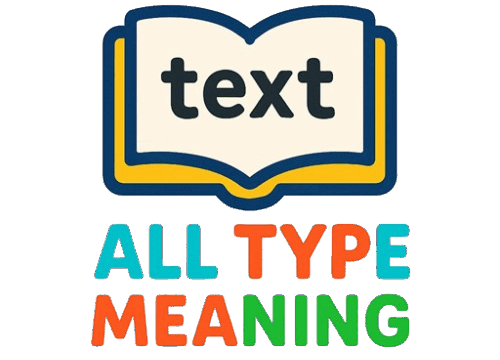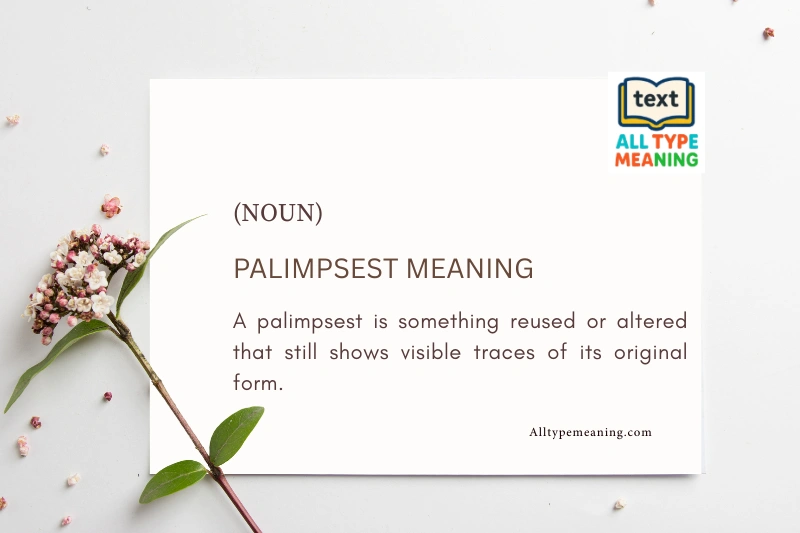Palimpsest meaning might sound like a complex word, but it carries a fascinating story within it. In simple terms, a palimpsest is something that has been reused or altered while still showing traces of its original form — like old manuscripts written over or cities built upon ancient ruins. Understanding this word helps us see how layers of history, memory, and creativity coexist around us.
For students, professionals, and language learners, learning the word palimpsest enhances vocabulary and deepens appreciation for culture, literature, and art. Dive in to explore its full meaning, rich examples, and everyday relevance in a way that’s both fun and insightful!
Quick Facts About Palimpsest
| Aspect | Details |
|---|---|
| Origin | Greek word “palímpsēstos” (παλίμψηστος) |
| Literal Meaning | “Scraped again” or “rubbed smooth again” |
| Time Period | Most common in Medieval times (5th-15th century) |
| Primary Use | Recycling expensive parchment/vellum |
| Modern Application | Literary device, metaphor, cultural analysis |
| Notable Examples | Archimedes Palimpsest, Syriac Gorgias Codex |
| Materials Used | Parchment, vellum (animal skin) |
| Detection Method | Ultraviolet light, X-ray imaging, multispectral imaging |
What is a Palimpsest? Understanding the Definition
A palimpsest (pronounced: PAL-imp-sest) is a manuscript page or piece of parchment that has been written on, scraped clean, and then reused for new text. Imagine having a very expensive notebook where you carefully erase your old notes to write new ones because paper is too costly to throw away – that’s essentially what a palimpsest is!
The palimpsest definition comes from the Greek words “palin” (meaning “again”) and “psestos” (meaning “rubbed smooth”). So literally, a palimpsest is something that has been “rubbed smooth again” to be reused. 📝
Why Were Palimpsests Created?
In ancient and medieval times, writing materials like parchment (made from animal skins) and vellum were incredibly expensive and difficult to produce. Creating a single book could take months and require the skins of dozens of animals! Because of this:
- Monks and scribes would often scrape off old text to reuse the precious parchment
- Religious texts were sometimes erased to make room for new religious writings
- Ancient scientific or literary works were occasionally replaced with more “relevant” contemporary texts
- Economic necessity drove the recycling of these valuable materials
The fascinating part? The original text wasn’t completely removed! The old ink would seep into the parchment, leaving faint traces that can still be discovered centuries later using modern technology. 🔬
The Historical Significance of Palimpsests
Palimpsests are like time capsules that hold multiple layers of human knowledge and history. They’re incredibly valuable to historians, archaeologists, and scholars because they provide:
Lost Texts Rediscovered
Many ancient works that were thought to be lost forever have been recovered from palimpsests. The most famous example is the Archimedes Palimpsest, discovered in 1906. This medieval prayer book contained erased texts from the ancient Greek mathematician Archimedes, including works that weren’t known to exist anywhere else in the world! 🌟
Through this palimpsest, scholars discovered:
- The Method of Mechanical Theorems
- Stomachion (a mathematical puzzle)
- On Floating Bodies (complete Greek text)
- Previously unknown mathematical principles that were 2,000 years ahead of their time
Religious and Cultural Transformation
Palimpsests also tell us stories about cultural shifts and priorities. For instance:
- Christian texts were often written over pagan works as Christianity spread
- Latin texts replaced Greek manuscripts as Latin became the dominant scholarly language
- Biblical texts were sometimes written over classical literature, showing changing values
- Language evolution can be tracked through the different layers of writing
Economic and Social History
The practice of creating palimpsests reveals important information about:
- The economic conditions of different time periods
- Which texts were considered valuable enough to preserve
- Which works were deemed less important and could be erased
- The literacy rates and educational priorities of various eras
Palimpsest in Modern Literature and Art
Literary Palimpsests
Modern authors use the concept of palimpsests in creative ways:
1. Intertextuality: When new stories reference, rewrite, or build upon older stories, they create literary palimpsests. For example:
- Wide Sargasso Sea by Jean Rhys rewrites Jane Eyre
- The Hours by Michael Cunningham layers stories across different time periods
- Modern retellings of Shakespeare plays or Greek myths
2. Narrative Structure: Some novels deliberately structure themselves like palimpsests, with multiple storylines layered on top of each other, revealing different truths as you read deeper.
3. Character Development: Characters who reinvent themselves while traces of their past remain visible are living palimpsests.
Cultural Palimpsests
Cities, landscapes, and cultures themselves can be seen as palimpsests:
- Architecture: Modern buildings built on ancient foundations, where different historical periods are visible in layers
- Cities: Rome, Athens, Istanbul – places where different civilizations have built over each other
- Language: English is a linguistic palimpsest, with layers of Latin, French, Germanic, and other influences
- Traditions: Modern customs that contain traces of ancient rituals and beliefs
Digital Palimpsests
In our modern age, we even have digital palimpsests:
- Edited photographs and videos (where original versions exist beneath)
- Websites that are redesigned but archive old versions
- Social media posts that are edited or deleted but leave digital traces
- Computer files that are overwritten but can sometimes be recovered
How Scientists Reveal Hidden Text in Palimpsests
The technology used to read ancient palimpsests is absolutely fascinating! Here’s how modern scientists uncover text that was erased centuries ago:
Traditional Methods
Ultraviolet Light (UV): The earliest method used to reveal hidden text. Different inks react differently to UV light, making the erased text visible. However, this method can sometimes damage fragile manuscripts. 💜
Chemical Reagents: Historical researchers sometimes used chemicals to make old ink visible, but this often permanently damaged the parchment. This method is no longer used.
Modern Techniques
Multispectral Imaging: This advanced technology captures images of the manuscript at different wavelengths of light (from ultraviolet to infrared). Different inks and layers of text become visible at different wavelengths. This method is non-invasive and incredibly effective! 🌈
X-Ray Fluorescence: This technique identifies the chemical elements in different inks, helping distinguish between layers of text without touching the manuscript.
Digital Processing: Computer algorithms can enhance the contrast between layers, making even the faintest traces of text readable.
Famous Discoveries Using Modern Technology
The Archimedes Palimpsest Project (1999-2008) used state-of-the-art imaging technology to reveal:
- Mathematical concepts that changed our understanding of ancient mathematics
- Diagrams and illustrations that had been hidden for centuries
- Text that was 90% illegible with the naked eye but became clear with imaging
The Metaphorical Power of Palimpsest Meaning Today
Understanding palimpsests meaning helps us think about life, memory, and identity in profound ways. Here’s why the concept remains relevant:
Personal Identity as Palimpsest
We are all living palimpsests! 🧠 Think about it:
- Our personalities are built on layers of experiences
- We constantly “rewrite” ourselves while traces of who we were remain
- Our memories are palimpsests – some clear, some faded, all layered together
- We can never completely erase our past, even when we try to move forward
Memory and History
History itself is a palimpsest where:
- Official narratives often cover up alternative stories
- Different groups remember the same events differently
- Archaeological discoveries reveal what was “erased” from historical records
- Every generation reinterprets history through its own lens
Environmental Palimpsests
Our planet is a geological and ecological palimpsest:
- Rock layers reveal Earth’s history
- Ecosystems build upon previous ecosystems
- Human impact on nature creates new layers while traces of wilderness remain
- Climate change reveals frozen history in melting glaciers
Learning and Education
The concept of palimpsests teaches us that:
- Learning isn’t about erasing old knowledge but building upon it
- Mistakes and failures are layers that contribute to success
- Understanding requires looking beneath the surface
- Nothing is ever completely lost if we know how to look for it
Conclusion:
The word palimpsest meaning something that has been reused or rewritten while still showing traces of its original form. Historically, it referred to ancient manuscripts where old text was erased and new writing was added due to the high cost of parchment. Over time, the term has evolved into a metaphor for anything layered with history — cities, cultures, memories, or identities.
Modern technology like multispectral imaging and X-ray fluorescence helps reveal erased texts, such as in the famous Archimedes Palimpsest. Today, “palimpsest” symbolizes how the past always leaves visible marks beneath the present. Explore our ultimate guide to the intriguing meaning of hiraeth meaning.
Frequently Asked Questions
Q1: What is the simple meaning of palimpsest?
A: A palimpsest is simply a piece of parchment or manuscript that has been written on, erased, and then written on again. The word comes from Greek and means “scraped again.” Today, it’s also used as a metaphor for anything that has multiple layers of meaning or history – like cities, cultures, or even people! 📖
Q2: Why were palimpsests created in ancient times?
A: Palimpsests were created primarily because writing materials like parchment and vellum were extremely expensive in ancient and medieval times. These materials were made from animal skins and took a lot of time and resources to produce. Instead of wasting precious parchment, scribes would scrape off old text and reuse the same material for new writing. It was essentially recycling before recycling was cool! ♻️
Q3: Can we still read the erased text on palimpsests?
A: Yes! Modern technology has made it possible to read text that was erased hundreds or even thousands of years ago. Scientists use techniques like multispectral imaging, ultraviolet light, and X-ray fluorescence to reveal hidden layers of text. The old ink seeps deep into the parchment and can’t be completely removed, so with the right technology, we can see what was written originally. It’s like magic, but it’s science! ✨
Q4: What is the most famous palimpsest?
A: The most famous palimpsest is probably the Archimedes Palimpsest. This 13th-century Byzantine prayer book contained erased mathematical texts written by the ancient Greek mathematician Archimedes in the 10th century. When it was analyzed using modern imaging technology between 1999-2008, scientists discovered previously unknown works by Archimedes, including mathematical concepts that were nearly 2,000 years ahead of their time! This discovery significantly changed our understanding of ancient mathematics. 🔢
Q5: How is the word palimpsest used in modern contexts?
A: Today, “palimpsest” is used as a powerful metaphor in many fields:
- Literature: To describe stories that reference or rewrite earlier stories
- Architecture: For buildings or cities with visible layers of different historical periods
- Psychology: To describe how our identities are built in layers over time
- Culture: To explain how traditions carry traces of older practices
- Technology: To describe edited digital content where original versions still exist somewhere
Essentially, anything with multiple layers of history or meaning can be called a palimpsest! 🎭
Explore word meanings, slang, and language tips at All Type Meaning!

